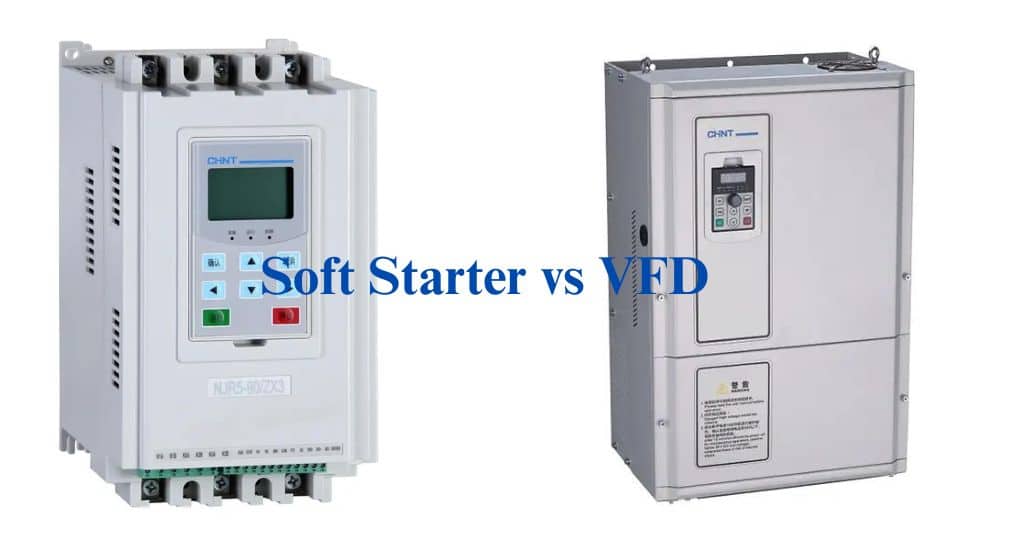Table of Contents |
Soft starters and variable frequency drives are both useful. However, their difference isn’t always clear. While both control motor speed and power, they do it in different manners. Learning how they differ can help you make an informed choice. This guide breaks down soft starter vs VFD to explain how they work and when you would use one over the other.
Soft Starters: Overview
The working principle of soft starters is straightforward. During electric motor startup, they slowly ramp up the voltage being supplied to it. In this way, they control high inrush currents. They achieve this through the use of SCR or thyristor technology. It individually fires semiconductor switches to gradually increase voltage over 2 to 5 seconds. This controlled soft start protects motors and drive systems. It does so by limiting excessive mechanical and electrical stress that can occur during direct-on-line starting.
By modulating the pace of voltage rise, soft starters ensure smooth, gentle acceleration that reduces torque surges. This makes them well-suited for applications with constant load requirements. These include conveyors, centrifuges, extruders, or positive displacement pumps. For such load profiles that demand fixed-speed operation after startup, soft starters provide a basic yet effective solution.
The simplicity and focus solely on current control during motor acceleration is beneficial. It means soft starters are generally more compact and affordable than variable-speed drives. However, soft starters do not regulate motor speed after the ramp-up period and are therefore limited to fixed-speed applications. This is a key motor soft starter vs VFD difference.
VFDs: Overview
Variable frequency drives control motor speed by using an inverter. The inverter here is a major soft starter vs VFD difference. It transforms the incoming DC power into adjustable three-phase AC output. It allows dynamic regulation of both voltage and frequency supplied to the motor. A key VFD vs soft starter difference is that in VFDs, an inverter module governs switching speed and waveform modulation to precisely vary output speeds.
Responsive control is a major soft starter vs VFD difference. VFDs provide highly responsive control unmatched by soft starters. They are well-suited for modulating loads like fans, pumps, and conveyors where process parameters require ongoing speed adjustments. VFDs also offer customizable acceleration/deceleration ramps and torque profiles.
The Comparison between Soft Starter vs VFD
The following table provides a visual soft starter vs VFD comparison based on various key aspects:
Aspect |
Soft Starter |
|
Working Principle |
Uses SCR/thyristor technology to slowly ramp up voltage being supplied to the motor during startup. It controls startup current and torque surges. This is done by individually firing the SCRs. |
Uses an inverter to convert incoming DC power to three-phase AC power. An inverter module with variable frequency capabilities is used. It modulates the pulse width and regulates the frequency/voltage of the output power sent to the motor. |
Function |
Performs soft starts by limiting motor current and torque at startup only. Does not control speed after startup. |
Regulates motor speed throughout the operation by adjusting output frequency and voltage. Provides dynamic control of speed, torque, and power. |
Price |
Generally lower initial cost. |
Higher initial investment. |
Size |
More compact footprint as only basic starting components are needed. Can be wall or DIN rail mounted. |
Larger chassis needed to house more sophisticated components. These include the rectifier, filter, and inverter. Requires a larger floor/wall-mounted enclosure. |
Application |
Ideal for constant torque loads like conveyors and extruders that require gentle ramp-up. Suits applications where speed is fixed after startup. |
Well-suited for variable torque loads like fans and pumps needing dynamic speed adjustment for process parameters. Applied where variable speed operation is essential. |
Conclusion
The above soft starter vs VFD comparison highlights key differences. While both soft starters and VFDs aim to protect motors, their capabilities differ. Soft starters handle starting needs simply and economically. VFDs, on the other hand, enable more complex speed control for optimal processes. As a global expert in motor control solutions, CHINT provides reliable soft starters and VFDs to customers. Our products meet demanding industries’ requirements with durability, flexibility, and ease of use. Our advantages include (but are not limited to):
Broad product portfolio for every motor and budget
International certifications give peace of mind for safety
Seasoned experts offer personalized technical support
Customizable configurations to perfectly fit any application
Cloud-connect capabilities advance remote monitoring and maintenance
At CHINT, we strive to lower customers’ energy costs through optimized control and intelligent connectivity. We help industries transition to low-carbon operations with smart, sustainable solutions tailored for the future of manufacturing and beyond. Visit our website to explore all of our soft starter and VFD solutions.













